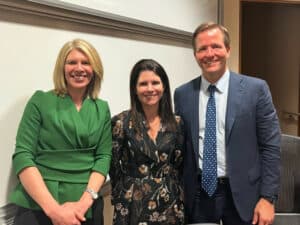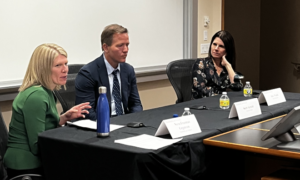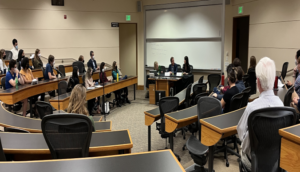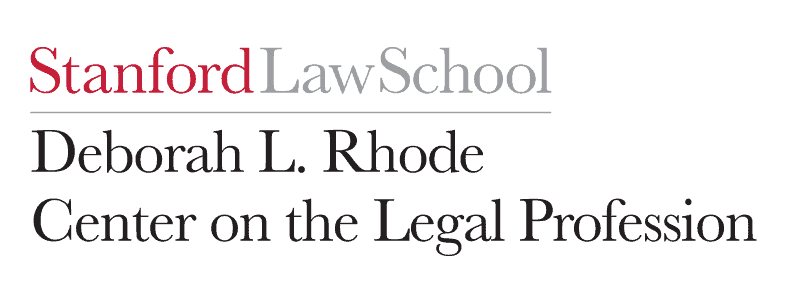
Lena Nelson and Jessica Seigel, Co-Presidents of the Stanford’s Plaintiffs’ Lawyers Association (PLA), here. We are guest posting this week to discuss PLA’s recent event co-hosted with the Deborah L. Rhode Center on the Legal Profession. The event, “Debunking the Myth of the Ambulance Chaser,” featured two plaintiff-side attorneys: Alexandra Walsh, JD ‘01 (Walsh Law) and Kurt Arnold (Arnold & Itkin). Professor Nora Freeman Engstrom, co-director of the Center on the Legal Profession, moderated the event.
Plaintiffs’ lawyers have historically gotten a bad rap among lawyers and law students. Lawyers consistently rank the plaintiffs’ bar, and especially the personal injury bar, low in terms of professional prestige. On law school campuses, and especially those of the most elite law schools in the U.S., career services centers have typically ignored plaintiffs’ firms. Career offices often concentrate on corporate practice, funneling students to “big law,” while public interest centers concentrate on government and nonprofit career opportunities. Students seeking opportunities in plaintiff-side practice often find themselves in a career advising no-man’s land.
This is beginning to change. As students seek a more diverse range of career paths, they have begun to express interests in plaintiff-side practice as a “best-of-both-worlds” somewhere between the typical public interest/big law dichotomy. And, in recent years, plaintiff-side firms have started to interview students as part of On Campus Interview programs. But, despite these constructive changes, gaps in information, perception, and opportunities remain.
At the same time as student interest is growing, civil plaintiffs’ practice is itself underdoing several transformations. In 2019, multidistrict litigation (MDL) rose to dominate the federal civil docket, and MDLs continue to compose more than half of federal civil caseloads nationwide. This rise in MDLs presents new opportunities for plaintiffs’ lawyers to serve in leadership positions and to help achieve innovative and fair resolutions to major public health calamities and corporate misfeasance. Also notable is the rise in alternative methods of litigation finance. Although third-party financing is somewhat controversial, it also is possible that new financing options could lower the barrier to entry for new plaintiffs’ lawyers and/or mitigate the risk associated with the work. This could open the doors for interested parties typically nervous about taking on such risk to enter the practice. Diversity issues are endemic to the legal practice, and the plaintiffs’ bar is no exception. When capital and risk are prerequisites to practice, it is no surprise that these inequities have persisted in plaintiffs’ practice. But, plaintiffs’ firms are taking steps to improve the problem. And to some extent, these efforts are bearing out results: the number of women plaintiffs’ lawyers leading complex litigation is increasing.
PLA’s event fell at the center of these two trends: evolving aspects of plaintiff-side practice and growing student interest.
In response to these trends, we’ve focused on growing Stanford PLA this year and fostering discussions around the diverse opportunities, ongoing trends, and new frontiers in plaintiff side practice. PLA’s most recent event featured two plaintiffs’ attorneys, Kurt Arnold of Arnold & Itkin and Alex Walsh of Walsh Law. Kurt has had a long career representing plaintiffs as a personal injury trial lawyer, and Alex recently left a successful career as a corporate lawyer to represent plaintiffs in mass tort litigation.
The event focused on two key issues at the intersection of plaintiffs’ personal injury law and student interest in the practice—the roots of the bias against plaintiff side attorneys, including complaints about frivolous lawsuits, overly inclusive MDLs, and attorney advertising—and students’ growing interest in plaintiff side practice.
Addressing the “myth of the ambulance chaser,” Professor Engstrom asked the panelists where the root of the bias against plaintiff attorneys might come from. The answers among the panelists varied. Kurt focused on lawyers’ frequent discomfort with television advertising, which many view as sleazy and even predatory. But, as Professor Engstrom explained, scholarly research has actually shown that the public’s perception of these ads is quite positive. Indeed, those who file complaints regarding lawyer advertising are usually lawyers themselves. Our colleagues in the legal profession are the ones who view attorney advertising as distasteful. The broader public, including those who may have been harmed by a faulty medical device or a dangerous drug, typically appreciate these commercials. Without them, they may not know the root of their harm, or that they have avenues for redress. Attorney advertising might also expand access to the justice system—a necessary step in a system where most tort victims lack representation.

The panelists agreed that some of the bias may also come from a mix of judgment in both the legal community and the general public that plaintiffs’ attorneys are “only in it for the money.” Both have faced this bias, and it seems baked into the career services chasm noted above. Everyone in the discussion admitted that certainly, in limited instances, these stereotypes are true. For instance, in MDLs, one plaintiffs’ lawyer may represent thousands of clients. As the attorney’s client “inventory” grows, the attorney becomes further and further removed from their injured clients. Sometimes, the incentive to settle for plaintiff’s’ counsel is massive, potentially creating a gap between the attorney’s interests and those of their client
Yet, plaintiffs’ lawyers regularly resist these temptations. Many plaintiffs’ attorneys are often client-oriented. Many seek to serve the public, helping those in need who have been harmed by large corporations—ranging from big oil companies to toy manufacturers to consumer product corporations. While this can be profitable work, few plaintiffs’ attorneys are in it for the money alone, including because the work comes with enormous risk: Working on a contingency can be profitable, but if those attorneys lose, they’ll never see a cent. The panel left one wrinkle undiscussed on this issue—while contingency fee work does allow plaintiffs’ attorneys to take on clients regardless of ability to pay, many attorneys can only take on those clients whose cases can pay. So on one hand, plaintiffs’ lawyers are restricted to the contingency fee model because their clients would otherwise not have representation. While on the other, it limits the cases that they will choose to take. have little choice but to use this model because their clients could not otherwise afford their services. Working on contingency is a massive risk, and one that might be easier for well-established firms. But for an attorney starting out on their own or a new firm trying to build, they can only take those cases that seem likely to yield a high reward.
And finally, the panelists discussed the idea that plaintiffs’ attorneys file frivolous lawsuits. The McDonald’s hot coffee case has branded the profession for (maybe) eternity. Kurt and Alex explained that, though there are few concerns about unmeritorious cases in single-client representation, there are some valid criticisms, particularly in large cases and MDLs. As noted above, as MDLs grow larger, the connection to each client shrinks. In one case against a pharmaceutical company, for example, a few plaintiffs were found to have never even taken the drug. To preserve the integrity of the MDL, plaintiffs’ attorneys must work diligently to screen clients, and the panelists agreed that the requisite thoroughness is sometimes missing.
The event also explored the reasons the panelists ventured into plaintiff side litigation, and why students seeking public interest careers might find joy in the space. Both attorneys talked about the client-focused nature of their work. They each explained the incredible feeling of connecting with a client, and more importantly, fighting tirelessly for that client’s relief. This ranged from single injury cases to mass torts.
Students, in turn, left the conversation understanding both how challenging and gratifying this practice can be. They also left with a deeper understanding of what personal injury practice actually entails: personal injury firms take on clients regardless of their ability to pay, investing in their case in the hopes of compensating them for their losses and deterring corporate actors from injuring others in the future. For students interested in public interest work, but for whom a firm might be the right fit, plaintiff side personal injury practice became a new option and opportunity.
practice can be. They also left with a deeper understanding of what personal injury practice actually entails: personal injury firms take on clients regardless of their ability to pay, investing in their case in the hopes of compensating them for their losses and deterring corporate actors from injuring others in the future. For students interested in public interest work, but for whom a firm might be the right fit, plaintiff side personal injury practice became a new option and opportunity.
The choice presented to law students has long been “big law” or traditional public interest (government/nonprofit) work. But, for some law students, plaintiff side work presents an opportunity to work in the public interest, broadly defined, while also finding more financial security. Similarly, for those interested in big law but bothered by the clientele or dismayed at the idea of spending their first few years after law school just digging through documents, plaintiff side practice offers an attractive alternative. Not only does the work more closely align with public interest practice, it also provides young attorneys the chance to do more exciting work sooner. Due to the firms’ smaller size, new attorneys at a plaintiff side firm have the chance to write key briefs, argue motions in court, and even go to trial in their first few years at the bar. For those students unexcited by their options in “big law” or concerned about the financial downsides of traditional public interest, this may just be a happy medium. It seems that the evolution of plaintiffs’ practice may coincide with a growing student interest in the “best-of-both-worlds” aspect of the practice.
